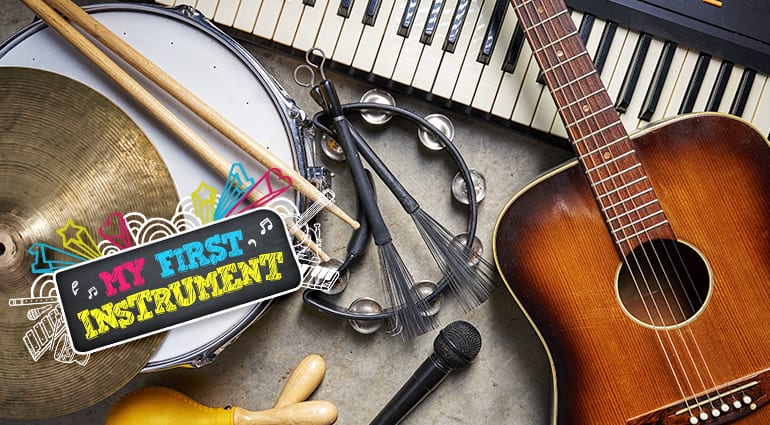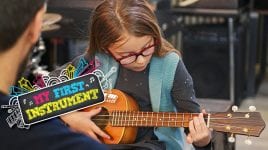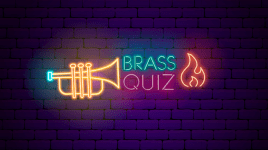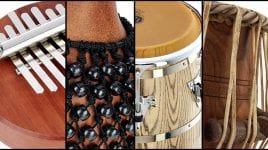
If you are looking for the right instrument for your kids, it can be helpful to distinguish properly between the instrument families. Maybe you have a generic term in your head, maybe you’re of a wind instrument or a stringed instrument. But which one? If you have an overview of instrument categories and their family members, you will definitely come a step closer to the decision:
Wind instruments
First, let’s take a look at wind instruments. We have to differentiate between two subgroups: the so-called woodwind instruments and the brass instruments. Contrary to what may be the first guess, the designations do not refer to the material from which these instruments are made, but instead mostly to the principle of sound generation. For example, a saxophone is usually made of metal, but the sound is generated when the air travels across a thin piece of wood called a reed and vibrates it. It’s about the mouthpiece. It is therefore assigned to the woodwind instruments. The classics of woodwind instruments are the recorder and the flute, the saxophone and the clarinet. Also the English horn. The bassoon and oboe join this family as instruments that are particularly at home in classical music.
- Startone SAS-75 Alto Sax
- F.A. Uebel 621KH Bb-Clarinet Children
And of course there are also somewhat more exotic instruments, such as bagpipes, the didgeridoo or the gigantic alphorn. All of them are characterized by their individual sound character.
The brass family forms the next strand of the family chronicle. The mouthpiece is responsible for the name here too; which is, appropriately, made of metal. The most prominent representatives are certainly the trumpet, cornet and flugelhorn, as well as the trombone and tuba. The somewhat more special brass instruments such as hunting horn or French horn are also popular.
- Thomann TR-5000 BG Bb- Trumpet
- Thomann FH-900 JSL JAZZ Bb-Flugelhorn
Stringed instruments
We also have to consider the stringed instruments in two parts. The two family lines are the plucked instruments and the bowed instruments. The guitar, in all its facets as an electric guitar, classical or steel string acoustic guitar, is one of the most popular instruments and leads the plucked instruments, although it is often not plucked at all.
The no-less-popular bass is responsible for the low end, especially as an electric bass. More special representatives of the plucked string team are, for example, the banjo, the mandolin or the cutting-edge ukulele. Especially for traditional folk or classical music, the zither, the dulcimer and in particular the beautiful sounding harp come to mind.
- Thomann Classic Guitar 3/4 Bundle 3
- Fender SQ Affinity PJ Bass Pack BLK
- Harley Benton HBMA-50E Mandolin VS
- Thomann Celtic Harp Ashwood 22 Str.
If we look at the bowed instruments, we immediately notice that we are much more clearly in the classical department. The obvious leader is the violin, which, many don’t know, can also be used in a contemporary and multifaceted manner. The viola, cello and especially the double bass sound a little warmer and deeper.
- Thomann Student Violinset 4/4
- Stentor SR1102 Cello Student I 3/4
- Thomann 33NA 3/4 Europe Double Bass
Percussion instruments
When we hear the term “percussion instruments”, many of us immediately have the drums come to mind. Partly correct, especially since there are various drums, cymbals and often percussion accessories on the drum set. However, there are numerous other popular percussion instruments such as the parade drum, timpani or bongos.
- Millenium MX Junior Earprotection Bundle
The cajon, or “musical box”, is currently experiencing a worldwide resurgence in popularity. Percussion instruments such as the guiro, various rattles or the triangle enable very diverse rhythms. And the xylophone, vibraphone , glockenspiel or metallophone are equally suitable for early musical education as well as concert music.
- Gewa Triangle 10 cm
- LP 243 Super Guiro
- Thomann Glockenspiel THTG2.5
Keyboard instruments
Let us come to the keyboard instruments and let us afford ourselves a deliberate faux pas: Accordions are an easy-to-learn and popular instrument, especially in the version with keys, which is why we want to count them among the keyboard instruments here. Sure, it’s actually a hand-held instrument, but we don’t want to be too picky here. Another example is the melodica, great for beginners and experts.
- Hohner XS Children Accordion
- Thomann Melodica
The piano has a high, if not the highest, status among the keyboard instruments, hand in hand with its immediate relatives, the electric piano, the keyboard and the diverse, and ever-evolving, selection of synthesizer models. The organ seems a bit outdated as a classic, the harpsichord even more so, but they are also keyboard candidates with an individual sound character and can be a lot of fun.
- Roth & Junius RJP 118 E/P Piano
- Thomann DP-26
- Casio CT-S200 BK Set
- Behringer Poly D synthesizer
No claim to completeness
There are numerous instruments in different moods as well as sizes suitable for children and schoolchildren, probably important criteria for your decision. This list cannot be complete, especially since there are so many unusual and exotic instruments in addition to the classics.
You are currently viewing a placeholder content from Facebook. To access the actual content, click the button below. Please note that doing so will share data with third-party providers.
More InformationYou are currently viewing a placeholder content from Instagram. To access the actual content, click the button below. Please note that doing so will share data with third-party providers.
More InformationYou are currently viewing a placeholder content from X. To access the actual content, click the button below. Please note that doing so will share data with third-party providers.
More Information

























